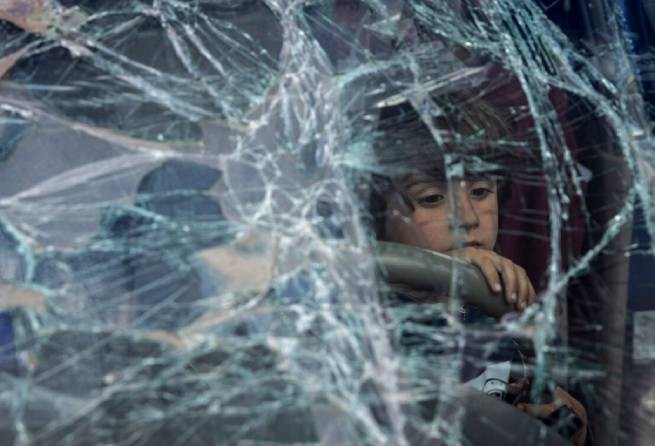Wars in Ukraine, Gaza and Sudan have made millions of children orphans and refugees, and millions more trapped in war zones. Non-childhood traumatic experiences will remain with them for many years.
Selma Bacevac, who lived in Sarajevo in 1992 when war broke out in Bosnia, remembers that she was seven years old at the time. The girl’s life changed overnight. Her father went to the front, and she had to hide from shelling, she survived the bombings and eventually lost her home.
Even games were dangerous at that time. Like other children affected by the war, he and his brother played war and refugees, drawing bombs and explosions. One day, when she went to the market with her father to buy a doll, a mortar shell hit the crowd, killing 68 people. She lost her doll and all her toys in a fire when her house was blown up.
The girl’s family fled the war in 1994, spending three years in a refugee camp in Germany before settling in the United States. Today, at age 38, she works as a psychotherapist specializing in trauma. Many of her clients also survived the war.
Bacevac, tells The Air Force may become a benchmark for how resilient children are. But there is something that people don’t see, she says:
“As a child, when you don’t feel safe, it affects your ability to communicate with yourself. This affects your ability to trust your environment, the adults. We are afraid of commitment, afraid to set boundaries, afraid to speak up, afraid of being seen. It’s not something you can just get rid of. This is what stays with you.”
Often, especially after a war or natural disaster, you hear that children are resilient. It’s true, experts say. They have the ability to overcome severe adversity, especially if they are helped by certain protective factors, such as a close bond with a caregiver. At the same time, over the course of many years of research, scientists have come to the conclusion that various types of trauma received in childhood (even in infancy) can “rewire” a child’s nervous system, changing the course of its development, increasing the risk of mental disorders and even physical health for a long time.
Since the late 1990s, a frequently used method for understanding the prevalence and impact of traumatic events in childhood is the Adverse Childhood Experiences Screen, which includes incidents such as sexual abuse, parental incarceration, and divorce. The more these experiences a child has, the more likely he is to experience depression, anxiety, and substance abuse.
However, adverse childhood experiences do not tell the whole story. The initial list does not include the impact of war or terrorism, although it is estimated that in 2023, one in six children in the world (468 million children) will live in active conflict zones. This is double the number of children affected by war in the mid-1990s.
More than half of Ukrainian children were displaced in the first month of the war with Russia following a full-scale invasion in 2022, according to UNICEF. At the same time, more than 500 children were killed and more than 1,100 were injured as a result of shelling.
In the Gaza Strip, which UNICEF spokesman James Elder called “the most dangerous place in the world to be a child”, some 850,000 children have been forced from their homes and lost their homes. It is estimated that more than 11,000 children in the Gaza Strip were killed by the Israelis.
According to health officials in the Palestinian enclave, since the war began in October 2023, this number does not include those trapped under rubble or deaths related to other causes caused by the war, such as hunger or lack of sanitation services, the nonprofit said. Euro-Mediterranean Human Rights Monitor.
In Israel, up to 40 of the 253 hostages and about 30 of those killed by Hamas were children, and some 126,000 Israelis, including thousands of children, were forced from their homes during the war. In Sudan, some 4 million children have been displaced by the war that erupted in the country last year, with “an alarming number of children killed, raped or recruited” and more than 700,000 likely suffering from severe malnutrition, according to UNICEF. according to UNICEF.
All of these children often experience multiple traumatic events at the same time and are at much higher risk of mental health disorders: post-traumatic stress, depression and anxiety. Their long-term physical health also tends to deteriorate.
For example, a study of German children injured during World War II found that as adults they were twice as likely to develop congestive heart failure, three and a half times as likely to have a stroke, and five times as likely to develop heart failure. oncology, writes CNN Greece.
Teresa Betancourt, director of the Children and Adversity Research Program at Boston College University and a longtime researcher on the impact of armed conflict on children, says:
“Scientists are increasingly recognizing that – given that exposure to trauma and violence causes strong physiological responses – repeated exposure can lead to disruptions in stress physiology and self-regulatory systems. Particularly in situations where caregivers are unable to provide support and protection, the effects of trauma can manifest as impaired cortisol responses and changes in inflammatory processes.”
The higher risks relate to the way traumatic events can rewire a child’s developing nervous system. When children grow up in violent environments such as war, their emotional reactions and fear often shift to a high level of vigilance in order to survive. Even when the threat has disappeared, they remain vigilant and react sharply to any external sign as if it were a threat.
The key factor, experts say, is not just the presence of a traumatic event, but also its severity, how long it persists, and how it interacts with other traumas. Jörg Fegert, director of the clinic for child and adolescent psychiatry at Ulm University Hospital in Germany, says:
“Trauma is a clinical category. This is a special mental reaction to a potentially life-threatening event.”
In situations of complex trauma, it is unrealistic to expect children to show “resilience” in the sense that the general public understands – returning to the way things were before, experts warn. Melissa Brymer, director of the terrorism and disaster program at the National Childhood Traumatic Stress Network in the United States, supports communities after crises such as school shootings or natural disasters. She says:
“There is trauma, but there is also sadness. The essence of resilience is that you “bounce back.” But you won’t recover from, say, the death of a loved one. You give it meaning, you honor what that person meant to you, you learn to adapt to a way of life without that person.”
Likewise, in crises that involve so many traumatic experiences at once, such as war, it is unrealistic to believe that life can return to “normal,” experts say:
“When we talk about the impact of war on children, we are definitely talking about threats to life, survival and trauma. But we are also talking about the destruction of the social fabric of everyday life. Children may lose caregivers, stop going to school, or lose their home. It’s not just that these complex traumas put them at higher risk of poorer developmental outcomes, but we need to think about what that means for identity and meaning-making.”
The idea that these crises are creating a kind of “lost generation” is wrong and even insulting, experts say. At the same time, to support children experiencing trauma, it is not enough to simply rely on the idea that “kids are resilient” and will “figure it out” on their own.
They say the international community must focus not only on immediate humanitarian needs such as food and shelter, but also on long-term needs to provide community and family support, social services and permanent infrastructure such as stable living conditions and health care. Care. Brymer says: “Children are absolutely resilient. But we need to give them the support they need to remain resilient.”







More Stories
Tariffs for "green electricity": detailed prices by suppliers for May
Child Benefit: Find out when the application platform will be temporarily closed
Greek Police: "Pyrotechnics for Easter are not toys for you"